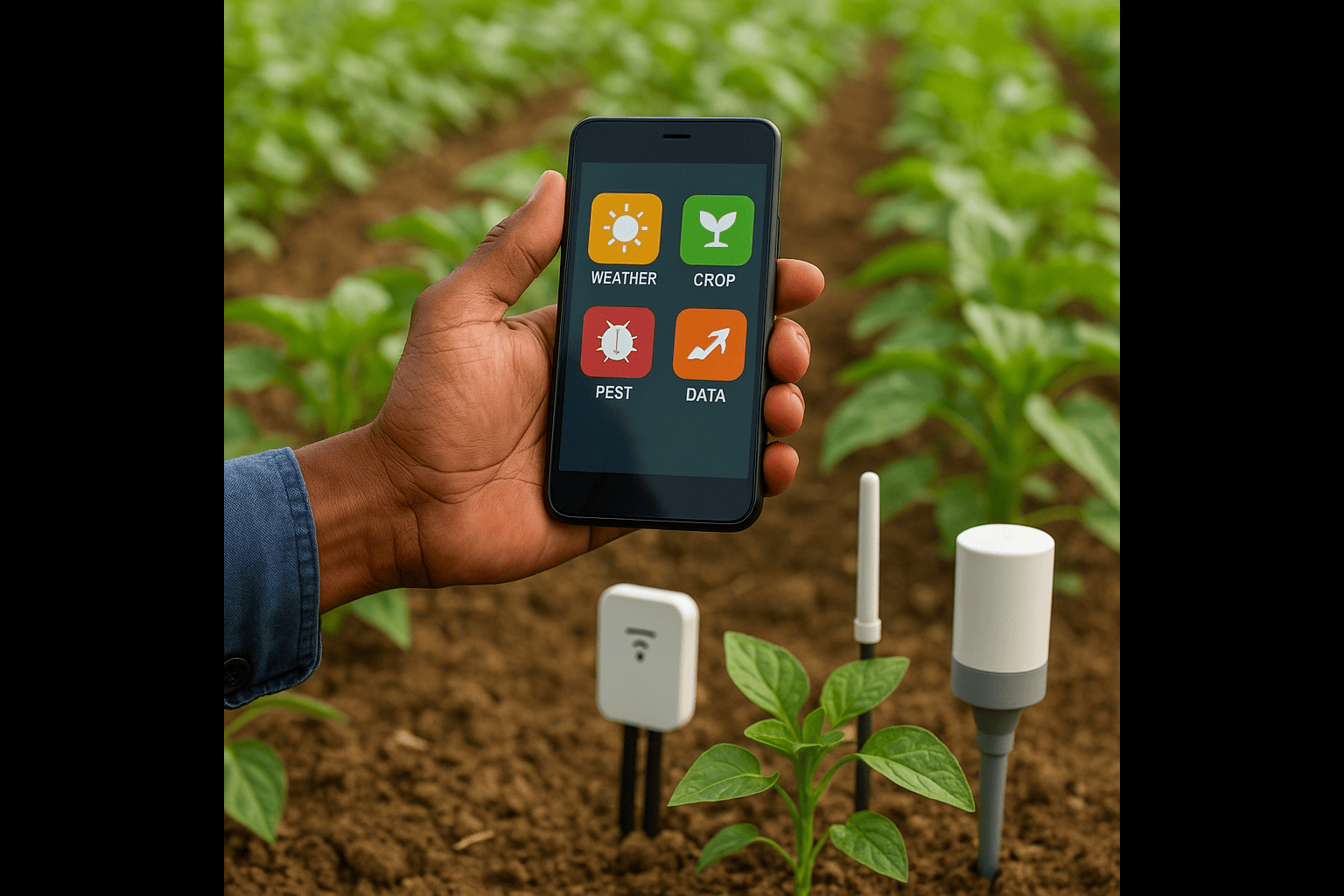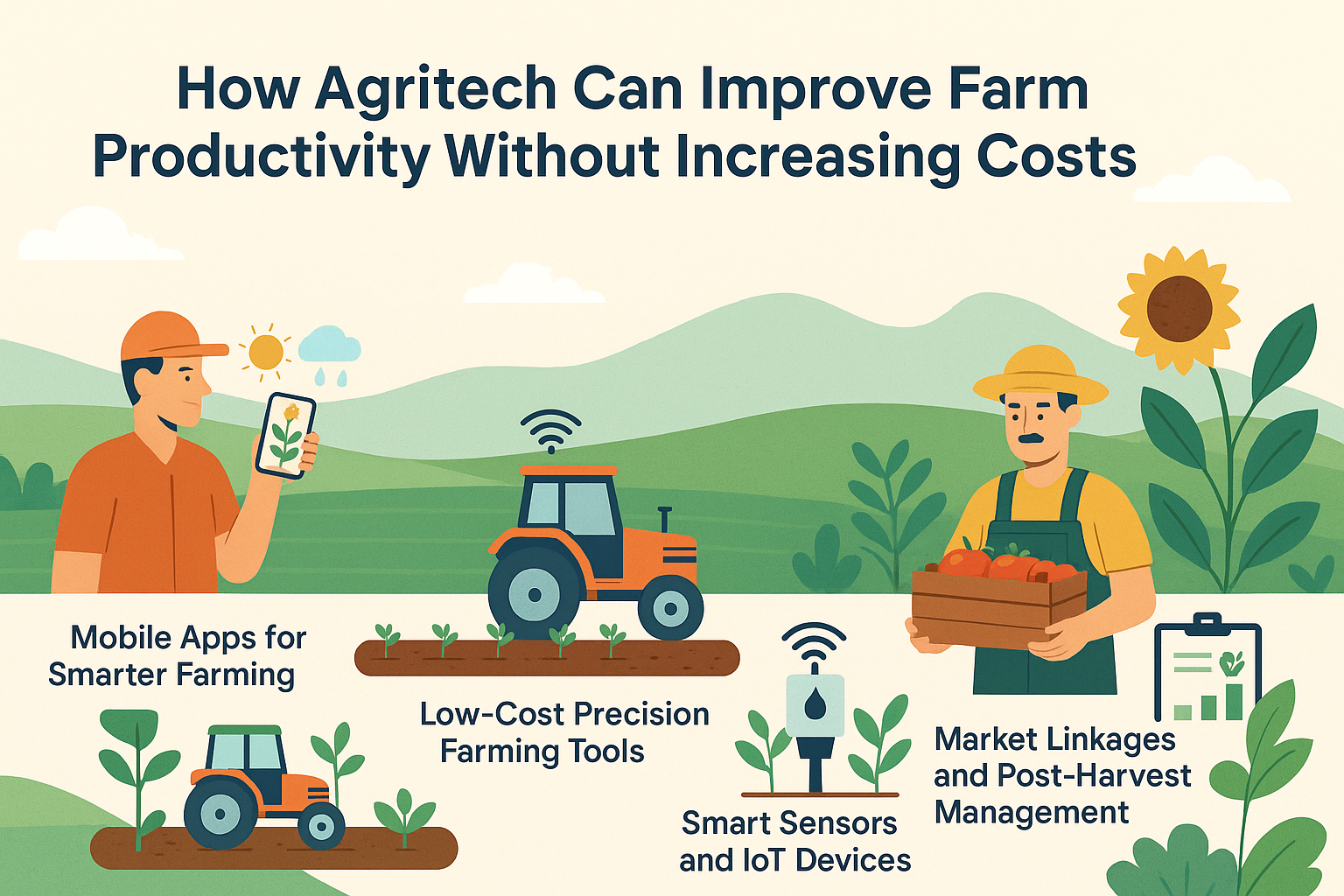Indian farmers are the backbone of the country’s food supply, working tirelessly despite challenges like rising costs, uncertain weather, and shrinking resources. Today, they face a key question: How can farm productivity increase without increasing input costs?
The answer lies in Agritech — the smart use of agricultural technology. Contrary to popular belief, Agritech isn’t just for large farms or wealthy growers. In fact, many modern solutions are designed to be affordable, accessible, and easy to use, even for small and marginal farmers.
This article explores how Agritech can help improve productivity in Indian agriculture while keeping farming costs under control. From mobile apps to precision tools and smart sensors, we’ll cover real-world solutions that make a real difference.
What Is Agritech?
Agritech, short for agricultural technology, refers to innovations that use science, data, and digital tools to solve farming problems. These include:
- Weather prediction apps
- Precision farming tools
- Soil testing kits
- Market intelligence platforms
- Post-harvest management systems
Such technologies are helping farmers make smarter decisions, improve crop health, reduce input waste, and earn better incomes. Most importantly, many of these tools are low-cost or available through shared models — making them suitable for all types of farms.
Why India Needs Agritech Now?
Farming has become more complex due to:
- Climate change, causing unpredictable weather
- High input prices for fertilizers, pesticides, and seeds
- Labor shortages during critical seasons
- Market fluctuations in crop prices
Traditional practices are no longer enough to deal with these challenges. Farmers need data-driven, efficient, and reliable solutions that improve yields without adding financial stress.
Affordable Agritech Solutions That Work
Let’s explore how simple Agritech tools can make farming more productive, without requiring high investments.
1. Mobile Apps for Smarter Farming

Smartphones have reached even the most remote farming villages. Today, mobile apps offer:
- Real-time weather forecasts
- Crop protection advice
- Pest and disease alerts
- Seed and fertilizer recommendations
- Local market price tracking
These tools empower farmers to take the right actions at the right time, improving both yield and quality. A simple weather alert can prevent unnecessary irrigation or spraying, saving both water and input costs.
2. Low-Cost Precision Farming Tools
Precision farming is about using inputs more accurately and efficiently. Affordable technologies include:
- Soil health testing kits, which guides optimal fertilizer use
- Seed drill attachments for uniform planting
- Portable pH meters and nutrient analyzers
These tools help avoid overuse of fertilizers and pesticides, reducing costs and minimizing environmental impact. Even small improvements in spacing or nutrient balance can result in higher yields and better crop health.
3. Smart Sensors and IoT Devices

Affordable IoT (Internet of Things) devices are helping smallholder farmers monitor:
- Soil moisture
- Weather conditions
- Pest presence
- Crop growth stages
These smart sensors provide real-time data to farmers’ mobile phones. For example, a soil moisture sensor can help apply just the right amount of water, avoiding wastage and preventing crop stress.
4. Drones and Satellite Imaging (Available as a Service)
While owning a drone may be costly, many local service providers and cooperatives now offer drone services on rent. Farmers can use drones for:
- Crop spraying
- Aerial field surveys
- Early disease or pest detection
- Farm mapping
By sharing the service among groups or villages, costs come down significantly while the benefits remain high — such as better coverage, time saved, and reduced manual labor.
5. Market Linkages and Post-Harvest Management
Agritech is also transforming what happens after the harvest — an area where farmers often lose value due to poor infrastructure and middlemen.
Tech-enabled platforms now offer:
- Storage and warehousing facilities
- Quality grading and testing
- Digital marketplaces and auctions
- Real-time buyer connections
- Access to loans and insurance
These systems ensure that farmers can sell their produce at the right time and right price, reducing waste and improving income without changing how they farm.
Real-Life Examples of Impact
Across India, thousands of farmers are already benefiting from Agritech — without increasing their costs.
In Gujarat
Groundnut farmers began using mobile-based pest alerts and saved 20% on pesticide costs, while still increasing yield.
In Tamil Nadu
Banana growers adopted affordable irrigation timers connected to soil sensors. Water use dropped by 35%, and plant health improved noticeably.
In Uttar Pradesh
Smallholder wheat farmers formed a cooperative to share a rented drone. Their spraying costs dropped by half, and they saw faster disease control.
These examples prove that smart solutions don’t need to be expensive to be effective.
How to Adopt Agritech Without Spending More?
If you’re wondering how to get started, here are some practical tips to adopt Agritech affordably:
- Begin with mobile apps – Choose one for weather or crop guidance
- Get your soil tested – Many local agri centers offer this service at minimal cost
- Join or form a farmer group – Share sensors, drones, or testing kits
- Use local agricultural extension services – They often offer subsidized tools or training
- Connect with agri service providers – Many now offer pay-per-use models that reduce upfront investment
The key is to take small but smart steps. Even one technology change can lead to big improvements in farm efficiency and returns.
The Long-Term Benefits of Smart Farming
While initial changes might seem small, the long-term benefits of Agritech adoption are big:
- Reduced input costs (fertilizers, water, pesticides)
- Improved crop health and yields
- Lower labor dependency
- Faster response to pest and weather challenges
- Better profits through quality and market access
Most importantly, smart farming helps build resilience against climate risks, which is crucial for future food security.
India’s Agritech Future Is Bright and Affordable
India is fast becoming a hub for agricultural innovation. With increasing digital access in rural areas and a rise in low-cost tech solutions, Agritech is no longer a luxury — it’s a necessity.
Farming is changing, and those who adapt early will lead the way. Whether you grow wheat in Punjab, pulses in Madhya Pradesh, or spices in Kerala — there are affordable tools to make your farm more productive and future-ready.
Partnering With Agritech Leaders
To make the most of these technologies, it helps to work with organizations that understand farming challenges and offer reliable solutions. At StarAgri, we are proud to be one of India’s leading Agritech firm, committed to empowering farmers through innovation and deep-rooted support. With our strong presence across agri-advisory, warehousing, post-harvest management, and market linkages, we help farmers increase productivity, reduce losses, and access better opportunities — all while keeping their costs in check. Our mission is to build a more efficient, transparent, and resilient agricultural ecosystem for India’s farming community.
You can also explore how the Ministry of Agriculture’s Digital Agriculture Mission is laying the groundwork for a farmer-centric digital ecosystem in India. The initiative aims to enhance productivity and improve farmer income through smart technologies and data-driven approaches.



